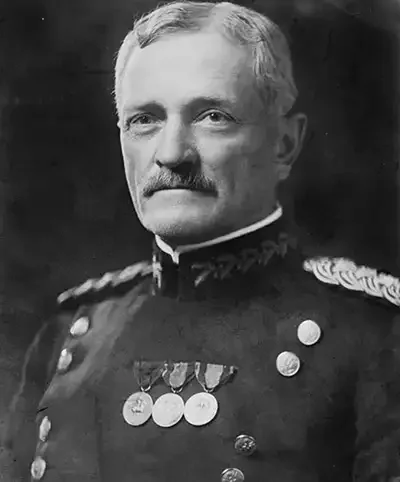- Military History
- Biographies
- Militarians Biographies
- General John Pershing
General John Pershing
An important military leader of his time, he served the United States in the Indian Wars, the Spanish-American War, the Philippines, the Mexican Intervention, and the First World War
John Joseph Pershing, a US Army general who commanded the AEF (American Expeditionary Force) during World War I, was born on September 13, 1860 on a farm near Laclede, Missouri, US.
After completing high school in 1878, Pershing became a teacher and taught African American children at a country school while additionally studying at the State Normal School (now Truman State University) in Kirksville, Missouri, from which he graduated in 1880 with a bachelor of science degree in scientific didactics.
Two years later, he was accepted into the US Military Academy at West Point, where he successively was appointed First Corporal, First Sergeant and First Lieutenant. Pershing graduated in 1886 as First Captain, the highest possible cadet rank.
Pershing became a cavalry lieutenant and was assigned to the 6th US Cavalry, which was first stationed at Fort Bayard, in the New Mexico Territory and until 1890 at various postings in California, Arizona and North Dakota. During this time, he took part in various battles of the Apache and Sioux Wars, including operations against the Geronimo and Chiricahua Apache, as well as the suppression of the Ghost Dance movement and an uprising of the Sioux.
In 1891 Pershing was appointed instructor of military science and tactics at the University of Nebraska and was promoted to first lieutenant a year later. While there, he attended the university’s law school and earned his law degree in 1893.
In 1895, he became the commander of a troop of the 10th Cavalry Regiment, one of the original Buffalo Soldiers regiments composed of African-American soldiers under white officers. Pershing commanded an expedition that herded together many Cree Indians and deported them to Canada.
In 1897, he became an instructor for military science and tactics at West Point. During the Spanish-American War (1898) Pershing served in Cuba as part of the 10th Cavalry. After the war, he was commissioned as a major of United States Volunteers and assigned as an ordnance officer.
In the following years he first was appointed adjutant general, organized the Bureau of Insular Affairs in the War Department, served in the Philippines where he fought in the Moro Wars, became major, was sent to Japan as military attaché to the US embassy and was the official US observer during the Russo-Japanese War.
Deeply impressed by Pershing's performance, US president Theodore Roosevelt promoted him to brigadier general in 1906, bypassing 862 more-senior officers. Pershing served three more years in the Philippines and then was sent to the Mexican border in 1915. He pursued the Mexican revolutionary Francisco "Pancho" Villa into Mexican territory.
After the US entered WW I, President Woodrow Wilson chose Pershing to command the American Expeditionary Force (AEF), American troops which were sent to the European battlefields. Pershing and his staff arrived in France in June 1917. As the AEF commander, he handled the organization, training, deployment and supply of a combined professional and draft Army and National Guard force, which grew from 27,000 inexperienced men to over 2 million soldiers at the end of the war.
Made a full general Pershing, who insisted on the integrity of the American army and who was determined to keep US troops together as a separate army, often and loudly clashed with both British and French allied military leaders such as French General and Commander of the Allied Forces Ferdinand Foch who wanted to integrate the American troops into the European armies. Their calls for him to be replaced were ignored and the grim, but effective Pershing remained the leader of the US forces in Europe.
Even though after the war criticized for operational and logistic errors, Pershing’s men won the crucial battles of Belleau Wood and Chateau Thierry, stopping the German offensive. In the last weeks of the war, Pershing coordinated a huge US offensive in the Meuse-Argonne area, destroying the last German resistance.
Named General of the Armies of the United States, the highest rank possible for any member of the United States armed forces, in 1919, Pershing returned home to tremendous praise from the US public and government. He hoped to be asked to run for the presidency in 1920, but never was. Until his retirement in 1924, he served as chief of staff. His memoirs, “My Experiences in the World War”, were first published in 1931 and received the Pulitzer Prize for History in 1932.
John Pershing died in Washington, D.C. on July 15, 1948. After a state funeral, he was laid to rest in the Arlington National Cemetery.
General John Pershing - Quick Facts
- 1st Army (United States)
- American Expeditionary Forces (United States 1917-1920)
- Chief of Staff (United States Army)
- United States Army
- Apache Wars (1849-1886)
- Sioux Wars (1854-1891)
- Spanish-American War (1898)
- Russo-Japanese War (1904-1905)
- Mexican Revolution (1910-1920)
- WWI (1914-1918)
- {{#owner}}
- {{#url}} {{#avatarSrc}}
{{name}} {{/url}} {{^url}} {{#avatar}} {{& avatar}} {{/avatar}} {{name}} {{/url}} - {{/owner}} {{#created}}
- {{created}} {{/created}}
























